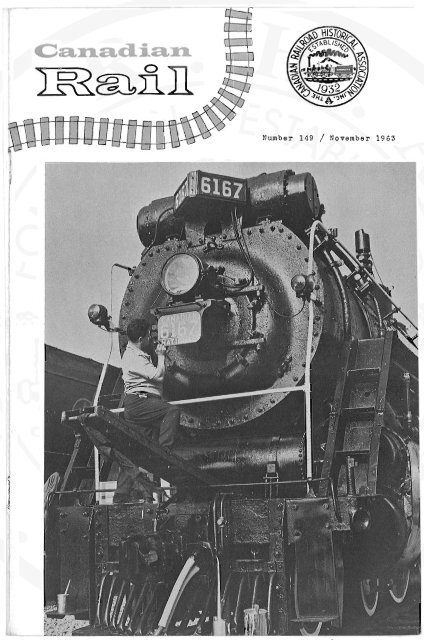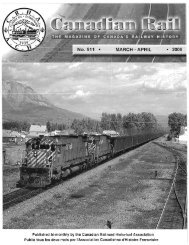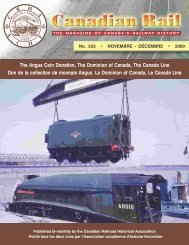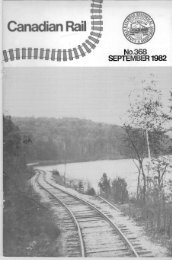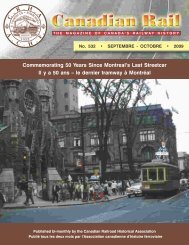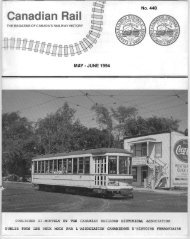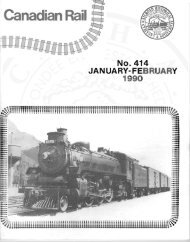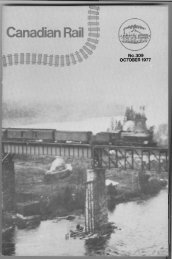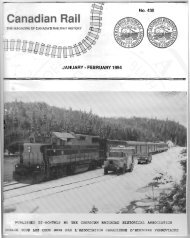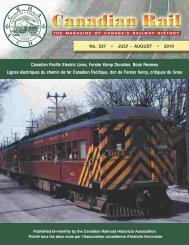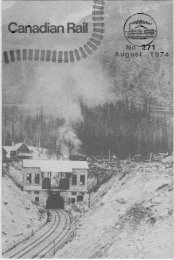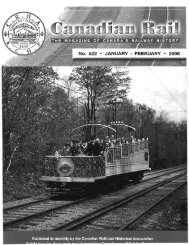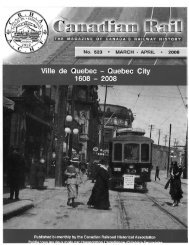Canadian Rail_no149_1963.pdf
Canadian Rail_no149_1963.pdf
Canadian Rail_no149_1963.pdf
You also want an ePaper? Increase the reach of your titles
YUMPU automatically turns print PDFs into web optimized ePapers that Google loves.
~a:n.adia:n.<br />
lffimfLn<br />
Number 149 / November 1963<br />
1<br />
i<br />
'1,
,\<br />
I '<br />
\' . 1<br />
!<br />
,<br />
:-' ,\<br />
,\'t<br />
' . ~<br />
~)<br />
\ \<br />
'\<br />
.... ,<br />
,It
Toronto Streetcar for Museum.<br />
Fred. Angus<br />
On July 18, 1963, Toronto Transit Commission streetcar No.2300<br />
arrived at Delson aboard C.P.R. flatcar 301038. No. 2300 was very<br />
kindly donated to the Association by the T.T.C. and before leaving<br />
Toronto's Hillcrest shops, had its gauge changed from TTC's 4 ft.<br />
10 7/8 inches to standard 4 ft. 8~ inches.<br />
This car is of considerable historic importance, as it was the<br />
first car built for the Toronto Transportation Commission when it<br />
took over the lines of the old Toronto <strong>Rail</strong>way Co. on Sept.l, 1921.<br />
At that time most of the T.R.'s cars were of wooden construction,<br />
some dating back to the 1890s, and the new Commission set about at<br />
once on a large scale modernization programme. The "Peter Witt" design<br />
was employed for the new cars, which were of steel and of the<br />
most advanced type of construction. The main feature of the Witt<br />
system was that entrance was by the front, and the conductor was<br />
situated halfway down the car. A passenger could either stay in<br />
the front half and pay as he left, or pay on passing the conductor<br />
and ride in the rear half of the car. In either case the exit was<br />
by a large door in the centre, there being no door in the rear.<br />
This made possible quick loading at car stops,and consequent speeding<br />
up of service.<br />
-- 1'1<br />
o<br />
oM<br />
...,<br />
o<br />
Q)<br />
::l<br />
o<br />
In all,between 1921 and 1923, the T.T.C. ordered 575 new cars.<br />
These were made up of 250 large motor cars 51 ft. long, 100 smaller<br />
motor cars 47 ft. long, and 225 trailers. The motors carried even<br />
numbers between 2300-2678,and 2700-3018, while the trailers had odd<br />
numbers between 2301-2419, and 2701-3029. These cars were built by<br />
<strong>Canadian</strong> Car and Foundry in Montreal (475 cars), Ottawa Car Mfg.Co.<br />
in Ottawa (50 cars), and Brill ($0 cars).<br />
No. 2300 was one of the "Large Witts", was built by Can-Car,<br />
and was the first of the order, being completed in August, 1921.<br />
The new equipment was first placed in service on Dctober 2, 1921,<br />
and the modernization progrrunme was completed in 1923. Subsequently<br />
no new cars were built until the year 1938 when the first PCC.s<br />
made their appearance.<br />
2300 saw some alterations during its years of service. In<br />
1935 in co~non with all Witts, a blue light was placed on the roof,<br />
as well as 4 lights on the dash. In 1936, the wooden seats were<br />
replaced by leather covered seats, and in the same year cars 2300-<br />
2322 were converted to pay-enter one man operation. Also, the gear<br />
ratio was changed to permit higher running speeds, as these cars<br />
were often used on the Long Branch route.<br />
In this somewhat changed form,2300 continued in passenger service<br />
until 19$1. In that year it became a training car, and continued<br />
in use as such until 1962, When, with the near complete retirement<br />
of non-P.C.C. equipment, car 4000,the first P.C.C. in Toronto,<br />
became the new training car, replacing 2300. For some time its fate<br />
remained in doubt, but,since the T.T.C. had offered the CRHA a Witt<br />
car,it was finally decided to choose 2300, as it was felt that such<br />
LEFT:<br />
The Toronto Transportation Commission's 2300 series<br />
were new when this photo was taken at the <strong>Canadian</strong> Car<br />
Foundry Company's plant opposite Turcot Yards in 1921.<br />
a surviving member of the class is being preserved at<br />
<strong>Canadian</strong> <strong>Rail</strong> Transportation Museum at Delson.<br />
cars<br />
and<br />
Now<br />
the
••••••• the fastenings seouring the tram were cut away,<br />
and at 4:00 p.m. on Saturday, July 27th,1963, No. 2300<br />
was pulled off T. T. C. rails for the last time •••••••<br />
Photo: Fred Angus<br />
an historic car, having survived in good condition for so long, deserved<br />
a better fate than being neglected and scrapped. Accordingly,<br />
the car was repaired and regauged at Hillcrest, a pair of TTC<br />
60 lb. rails fastened to the flatcar, and the streetcar was loaded<br />
and shipped to Delson, passing en route within a mile of the now<br />
abandoned Can-Car plant where it was built, 42 years ago.<br />
With 2300 at Delson aboard a flatcar, the big problem was how<br />
to unload a 51 ft., 25 ton streetcar without a crane. The problem<br />
was solved by jacking up the moveable portion of our "old faithful"<br />
stub switch, so forming a ramp up to the end of the flatcar. The<br />
fastenings securing 2300 were cut away, our gas electric No.9 moved<br />
gingerly up the ramp, coupled to the streetcar, and at 4:00 p.m. on<br />
Saturday, July 27, 1963, 2300 was pulled backwards off T.T.C. rails<br />
for the last time, and moved slowly and carefully down the ramp to<br />
"terra firma".<br />
By this method of unloading, the wiring and brake rigging were<br />
not disturbed, and the entire car is complete and in excellent condition.<br />
This is the only standard gauge Toronto Witt car in existence,and<br />
one of only two large T.T.C. Witts to have been preserved.<br />
Thus, No. 2300 fills a large gap in the C.R.H.A. collection, by representing<br />
both another <strong>Canadian</strong> city and a major type of electric<br />
railway vehicle. It will be an important exhibit in the museum at<br />
Delson.
J !<br />
' __ ~h.--:r-. -' --<br />
'-r!<br />
DD c==J<br />
DDc=J<br />
DDeD -~<br />
DO I ~h-'-~ "j I<br />
t" .f':' ~<br />
i!<br />
~<br />
~<br />
I-
to<br />
Vi ctoriavi lie<br />
by F. Angus and<br />
E. L. Modler.<br />
Anyone passlng through Montreal's Central Statlon on<br />
the mornlng of Sunday, October 27, 1963, could not have helped<br />
notlclng the large number of people oarrylng cameras, and sportlng<br />
ral1way badges, englneers' oaps and the 11ke. The reason for th1s<br />
was soon obvlousl thls was another C.R.H.A. steam excurslon.<br />
Thls year the destlnat10n was V1otor1avl11e, 106 m11es<br />
east of Montreal, and the mot1ve power was C.N.R. 's famous 4-8-4<br />
Northern type steam looomot1ve No. 6167. Th1s eng1ne has seen frequent<br />
use on exours10ns 1n the Toronto area in the last few years,<br />
but this day marked the f1rst time it was so used on a trip from<br />
Montreal. The summer-11ke weather wh1ch had set reoord high temperatures<br />
dur1ng much of Ootober oontinued through the 27th, and,<br />
despite some apprehens1on, the day was clear and br1ght, ideal for<br />
the trip.<br />
Departure time was set for 8:30 a.m. The long line of<br />
passengers slowlyd1sappeared through the gate lead1ng to the traok,<br />
and soon all but 30 of the enthusiasts were aboard. The rema1n1ng<br />
30 were due for a speo1al experienoe. Arrangements had been made<br />
to oharter an open-top bus whioh would pace the tra1n along the<br />
parallel h1ghway between St. Lambert and Beloe1l, a d1stance of<br />
some 20 m11es. The bus could be ridden by anyone who had an excursion<br />
ticket, and who paid a small addit1ona1 fare, and so, at 8:20,<br />
the bus departed from 1n front of Central Station. At 8134, Passenger<br />
extra 6167 East cons1st1ng of a 12-oar train of 9 coaohes,<br />
1 baggage car, and 2 Cafeter1a cars, steamed out of Montreal to<br />
start the memorable trlp. St. Lambert was passed at 8:50, on t1me,<br />
where the train beoame Work Extra 6167. Soon after the bus appeared<br />
in s1ght, paralleling the tra1n and affording a un1que opportunity<br />
of photograph1ng the eng1ne. Conversely, passengers on the train<br />
had a un1que opportun1ty of photograph1ng the bus -another C.R.H.A.<br />
first.<br />
At Beloeil the train stopped and the bus passengers boamed,<br />
bring1ng the total passenger list to 622, the most yet carr1ed<br />
on a C.R.H.A. trip. At this point we had the f1rst runpast of the<br />
day, and th1s was, 1n fact, a double feature. The train d1scharged<br />
some passengers at Beloeil, then performed a mov1e run, let off<br />
more people at Otterburn Park, aoross the R10helieu River, then<br />
made another run, and p1cked up both groups of people; thus one had<br />
the opportun1ty of photographlng the train from e1ther side of the<br />
r1ver. Departure from Otterburn Park was made at 9:48, and, follow-<br />
1ng a 24-m1nute water stop at St. Hyacinthe, a high speed runpast<br />
was made at Upton. The crews changed at R1chmond and more water<br />
was taken. Also, 120 bottles of Bull's Head Ginger Ale, kindly<br />
donated by Bryant's, were placed aboard. Those who were on last<br />
year's tr1p to Sherbrooke needed no 1ntroduction to Bull's Head,<br />
and this welcome donation was d1str1buted free of charge to the<br />
younger passengers. Then on to V1ctor1aville, wh1ch was reaohed at<br />
1:30.
Page 2 2 4<br />
<strong>Canadian</strong> <strong>Rail</strong><br />
On reaching Victoriaville, the entire train was turned<br />
on the Y, 6167 received coal and water, and at 3:12, the train<br />
pulled out on its return journey to Montreal. Two more runpasts<br />
were held at bridges at mileages 63.9 and 73.7, a further water<br />
stop and change of crew at Riohmond, and the train, now Passenger<br />
Extra 6167 West, prooeded. stopping at St. Hyacinthe for water and<br />
night photography, Beloeil and St. Lambert to disoharge passengers,<br />
and Bridge Street to ohange engines. Here, 6167 was taken off and<br />
replaced by electric engine 187, to the accompaniment of photographers'<br />
flash bulbs. Central Station was reached at 7:28 p.m., only<br />
3 minutes late, so completing another great C.R.H.A. trip.<br />
The C.R.H.A. and the Trip Committee take this opportunity<br />
to thank those whose efforts made this excursion a suooess.<br />
Speoial thanks is due to <strong>Canadian</strong> National <strong>Rail</strong>ways for their 00-<br />
operation, also to the Montreal Gazette, and to radio stations CJAD<br />
CFCF and CFOX, whose publicity made the trip known to many who would<br />
otherwise not have attended. Many others, too numerous to mention,<br />
also deserve our thanks.<br />
CANADIAN NATIONAL RAILWAYS Speoial # 437-63.<br />
Engines & orews: 6167, Montreal-Riohmond Engineer, C. Glenn<br />
Fireman, J.A.Dooner<br />
6167, Riohmond-Viot'ville Eng'r.,J.Parenteau<br />
Fireman, J.L.Roohefort<br />
187 (eleotric) Bridge St.-Montreal<br />
Engineer, H.Rondeau Helper,R.Chapleau<br />
Train crews: Montreal-Riohmond Conduotor Motugas<br />
Trainmen, M0rin and Brady.<br />
Richmond-Viotoriaville Conductor Legendre<br />
Trainmen, Labonte and Lacroix.<br />
Offioers:<br />
C.N.R. VI.Edge, Supervisor of Passenger Sales, Montreal Area.<br />
W.C.Buell, Transportation Offioer, Champlain Area.<br />
J.R.Brault, Asst.Superintendent, Champlain Area.<br />
E.O.Rood, Master Meohanio, Champlain Area.<br />
M.Chadwick, Sr.Asst.Foreman, Montreal Yd.Diesel Shop.<br />
CRHA. W.pnaroah and P.Murphy<br />
Consist:<br />
12 cars: Express oar 9131<br />
Coaohes 53~1, 5444, 5369, 5638, 5511, 5370,<br />
55 2, 5378, 5367<br />
Cafeteria cars 493, 497<br />
Weight of train (exoluding engine): 890 tons.<br />
Cover pho to and phO to s at right provided courts By J. Norman Lowe.
~ j. .• " .. . ~ : ..... ; ' •. J ~.:
Somewhat over twenty thousand persona visited the CNR's train<br />
and locomotive display at Dorval, Que., over the weekend of October<br />
18-20. Sharing the honours for attention were the National System's<br />
6153 and 40, the CRHA' a British locomotive "Waddon" and a partial<br />
consist of the CN'S "Super Continental". The equipment was lined<br />
up on the Dorval spur in the above-mentioned order, and visitors<br />
were invited to enter the cab of 6153 as well as tour through the<br />
renovated and refurbished cars of the Continental.<br />
Literature and information describing the historic steam engines<br />
were distributed by members of the CRHA, while CN representatives<br />
were on hand to answer queries regarding the passenger equipment.<br />
This included a modernized dining car, three sleeping cars,<br />
a lunch-counter car, the "Matinee" lounge and coach-lounge 3001. A<br />
diesel "A" unit was at the head-end to supply steam heat and to<br />
provide a finished appearance to the train.<br />
Photos:<br />
R. Half yard and A.Clegg
<strong>Canadian</strong> <strong>Rail</strong> Page 227<br />
Tk WINTER 1~<br />
NEW FARES, TRAINS, FOLDERS<br />
HIGH LI GHT FA 1.1 TIME CHANGE<br />
But Passenger Servioe Cuts Continue in Many Areas<br />
by Forster A. Kemp<br />
If a review of the new timetables<br />
of <strong>Canadian</strong> railways was to appear<br />
in the daily press, it might<br />
bear the above headline, for the<br />
end of Canada's summertime confusion<br />
(Daylight Saving Time) has<br />
been the occasion for <strong>Canadian</strong><br />
National to extend its "Red,White<br />
and Blue" passenger fares to<br />
\-lestern Canada and for <strong>Canadian</strong><br />
Pacific to introduce its competitive<br />
"Faresaver" plan, which is<br />
not quite so Calendar-bound as<br />
the CNR plan.<br />
THE NEW FOLDER S •<br />
The most strikin~ departure in the new folders has been in <strong>Canadian</strong><br />
Pacific Folder A", which now has a black cover, printed in<br />
red. Separate folders are to be provided for the French and English<br />
languages, although the appearance of the French edition was delayed<br />
due to an error. This ends a period of about seventy years during<br />
which "Folder A" has had a yellow cover. The interior layout haa<br />
changed very little, except for the system map, which has been<br />
changed back to the Poole Bros. 1938 edition from the more recent,<br />
but almost-unreadable, one in the April issue.<br />
The <strong>Canadian</strong> National abandoned its recent fascinating photographic<br />
mosaic covers in favour of a twelve-month calendar of RED,<br />
WHITE AND BLUE days, with some sample fares on the back. Inside<br />
the "equipment" tables have been separated from the schedules and<br />
put in the back of the book, in Official Guide fashion. The map and<br />
fares are also in the back. Tables have not been renumbered, making<br />
it easier to pinpoint discontinued passenger services.<br />
THE NEW TRAINS AND SERVICE CHANGES.<br />
<strong>Canadian</strong> National accounts for most of these, with much rescheduling<br />
of trains and re-assignment of equipment, including RDC<br />
units. The entire service between Moncton and Saint John, N.B., has<br />
been converted to <strong>Rail</strong>iners with an additional train (Nos.623 & 624)<br />
operating daily in each direction. Trains 643 and 644 now operate<br />
daily instead of six days a week.<br />
The Ottawa-Montreal service has been increased to five trains<br />
in each direction (3 express, 2 local) with the addition of lateevening<br />
train 49 leaving Montreal at 11:30 p.m. Trains 47 and 46<br />
now make the journey in 1 hour 59 minutes. Trains 45 and 50 are now<br />
locals between Coteau and Ottawa, as are 3 and 4 "Continental".<br />
Between Montreal and Toronto, extra Pool trains known as "Holiday<br />
Specials" have been introduced during the Christmas and New<br />
Years peak periods. These trains are scheduled to make the 335 mile<br />
journey in exactly 6 hours,the fastest timing since the early 1930s.
Page 228<br />
<strong>Canadian</strong> <strong>Rail</strong><br />
THE WINTER TIMETABLES -- con tinued<br />
In the Montreal-Vancouver service, the schedule of Train No.1<br />
the "Super Continental" has been reduced to 66 hours and that of No.<br />
2 to 65 hours, 40 minutes, finally bettering the famous 67 hour run<br />
made in 1925 by oil-electric railcar 15820. These trains now have<br />
all seats reserved in coaches and feature "refreshment lounges"<br />
(bars) for both coach and sleeping car passengers. These were provided<br />
by removing the smoking section of a 5435 series coach and the<br />
bedrooms am. buffet from a "fort"car and installing panelled lounges<br />
with venetian blinds and drapes. The lounge coaches are numbered in<br />
the 3000 series and the first-class lounge cars in the 2300 series;<br />
names and numbers will appear next month. Dinettes, as well as dining<br />
cars, will operate throughout the winter. The "Continental"<br />
Trains 3 and 4 now carry 8-section I-bedroom buffet sleepers between<br />
Montreal and Saskatoon, after two winters of coach-only operation.<br />
Connecting trains 177 and 178 now have coach accommodation in addition<br />
to the sleeper formerly carried.<br />
In the Montreal-Halifax service, coach seats on the "Ocean Limited"<br />
(trains 1 and 2) are now reserved, but the principal feature<br />
has been the re-appearance of trains 59 and 60 "The Scotian" as a<br />
full-fledged train with a diner and four regularly-assigned sleepers<br />
including a "Fort" bedroom buffet-lounge car (not all of them are<br />
being converted to lounges). The westbound "Scotian", departing from<br />
Halifax in the early evening, allows a better connection with the<br />
"Super Continental" at Montreal. The "Maritime Express" has become<br />
a Montreal-Campbellton local train with coaches and a cafeteria car.<br />
A connection to Moncton is provided by Train 104, but no sleeping<br />
cars are operated.<br />
SERVICE REDUCTIONS AND DISCONTINUANCES.<br />
The following passenger and mixed trains were discontinued,ending<br />
all service on the lines they served:<br />
RY. TRAIN NUMBER BETWEEN AND FREQ.UENCY REPLACEMENT<br />
CN Mixed 239-240 St .Felicien Chibougamau Tri-weekly None<br />
CN Bus 81-82 Longlac Fort William Daily Greyhound X<br />
CN Bus 79-80 Geraldton Longlac Daily Greyhound X<br />
CN Psgr. 5-6 Winnipeg Regina Ex. Sat. None<br />
CN Psgr. 9-10 Winnipeg Saskatoon 6 days wkly, None<br />
(discontinued May 18-passenger service ended between Canora and<br />
Saskatoon only - Winnipeg-Canora served by Trains 75-76)<br />
CN Psgr. 9-10 Saskatoon Calgary Tri-weekly None<br />
(discontinued May 16)<br />
CN Psgr. 693-694 Kamloops Jct.Kelowna Daily Greyhound<br />
CN Mixed 221-222 Saskatoon North Twice<br />
Battleford weekly none<br />
CP Psgr. 123-124 McAdam Edmunds ton Ex. Sun. None<br />
CP Psgr. 211-212 Moose Jaw Macklin Tri-weekly None<br />
X-The CN bus services made close connections with main line trains<br />
at Longlac. The Greyhound service does NOT connect with ANY CN<br />
train in EITHER direction at EITHER end of the run. This marks the<br />
end of scheduled bus services operated by <strong>Canadian</strong> National. The<br />
Detroit-Windsor bus service is operated by Greyhound under contract.
In Prince Edward Island. the mixed train servioes formerly operated<br />
six days weekly from Charlottetown to Souris. Georgetown. and<br />
Murray Harbour will operate three times weekly this year from Deo.16<br />
to April 25. Each<br />
train will leave Charlottetown<br />
in the morn<br />
PRINCE EDWARD ISLAND<br />
ing and return in the<br />
afternoon. The Murray<br />
Harbour train will run<br />
via Mt.Stewart Jet. to<br />
Lake Verde, thence to<br />
Hazelbrook, return to<br />
Lake Verde, then to<br />
Vernon (the famous<br />
loop) return to Lake<br />
Verde, thence to Murray<br />
Harbour, repeating<br />
the process on the return<br />
trip. Lake Verde<br />
thus has six trains a<br />
day~ The tri-weekly<br />
Summers ide Tignish<br />
mixed train will not<br />
operate this season.<br />
, •• r •• fMII ..<br />
.. .. ..<br />
Other trains discontinued include <strong>Rail</strong>iners 609-610 between<br />
Halifax and Moncton; 631-632 between Charny and Mont Joli; 197-198<br />
twice weekly between Senneterre and Chibougamau; 211-212 weekly<br />
mixed between Armstrong and Sioux Lookout; 215-216 weekly mixed between<br />
Redditt and Winnipeg; 215-216 weekly mixed between South Parry<br />
and Capreol.<br />
In Saskatchewan, tri-weekly Saskatoon-Hudson Bay Trains 31-32<br />
were replaced by <strong>Rail</strong>iners, quickening their schedules and adding<br />
the usual 600 to their numbers.<br />
<strong>Canadian</strong> Pacific Trains 427-428<br />
were deprived of their sleeping car<br />
straight coach trains.<br />
Sudbury-Sault Ste.Marie, Ont.,<br />
and buffet-coach and are now<br />
A FEW NOTES.<br />
Some of the service changes this year were not made at the<br />
change of time, but earlier. or, in one case, later. The withdrawal<br />
of CN Trains 9 and 10 was made in May, of CN 5 and 6 in June, and of<br />
CP Trains 211 and 212 in July. CP Trains 123 and 124 are scheduled<br />
to make their last trips between McAdam and Edmundston, N.B., Saturday,<br />
November 15.<br />
The new fares are not universal as yet, but it is simpler to<br />
state where they do NOT apply than where they do. These areas are<br />
as follows: Pool Service zones - Montreal-Quebec via Trois Rivieres<br />
(CP) and via Richmond (CN) - Montreal-Toronto and Ottawa-Toronto<br />
(except via Ottawa-new fares apply Montreal-Ottawa); Quebec & Montreal<br />
- Lac St. Jean area - Chicoutimi, Dolbeau (CN); Quebec & Montreal<br />
- Abitibi area - Senneterre - Rouyn - Cochrane (CN); Medicine<br />
Hat - Lethbridge - Nelson - Penticton - Spences Bridge (CP); International<br />
routes - Montreal - Boston and New York; Toronto - Chicago;<br />
Winnipeg-St.Paul and Vancouver-Seattle.<br />
On tlREDII days, it is cheaper to travel Montreal-Toronto via<br />
North Bay than over the direct route1
Page 230<br />
<strong>Canadian</strong> <strong>Rail</strong><br />
The M.T.C. Historical Collection.<br />
MOTOR FLAT CAR NO. 3151.<br />
R. M. Binns<br />
Fourofthese cars were built<br />
by <strong>Canadian</strong> Car and Foundry Co.in<br />
1925,- Nos. 3150 to 3153. Length<br />
over end sills is 34 ft. and the<br />
weight is 41,500 Ibs. The underframe<br />
is of steel, and the capacity<br />
is rated by CCF as 55,000<br />
Ibs.and by MTC 40,000 Ibs. Trucks<br />
are of the standard MTC freight<br />
car archbar type with GESO motors<br />
and GE402 control.<br />
Nos. 3150 and 3152 were converted<br />
to snow plows in 1950, -<br />
the latter being sold to Cornwall<br />
Street <strong>Rail</strong>way in 1957.<br />
No. 3151 was used for construction<br />
work and for carrying<br />
supplies, principally crossties,<br />
timber, castings, etc. It is<br />
equipped for side stakes.<br />
SINGLE TRUCK SWEEPER NO. 51.<br />
This was one of the more modern<br />
single truck sweepers in the<br />
MTC snow fighting fleet. Itis one<br />
of four (Nos. 50 to 53) built by<br />
Ottawa in 1925. The others were<br />
scrapped in 1957.<br />
No. 51 has high-speed brooms<br />
driven by bevel gears instead of<br />
chains. It is typical of much of<br />
the snow fighting equipment that<br />
kept <strong>Canadian</strong> street railways operating<br />
throuBh winter storms.The<br />
weight is 39,000 Ibs.
<strong>Canadian</strong> <strong>Rail</strong><br />
Page 231<br />
TO OL CAR NO. 3200.<br />
A number of special cars were<br />
employedby the MTC for transporting<br />
fare boxes to and from the<br />
Cashiers Dept. at Head Office.<br />
Two of the se, Nos. 3011 and 3012,<br />
were built at Youville Shops in<br />
1920 and 1922 respective ly. In<br />
1928 a third car was built, No.<br />
3200. Collection and delive ry of<br />
the boxes was made ona siding off<br />
Place diArmes Hill, b ehind the<br />
Head Office building then located<br />
on the southwest corner of Craig<br />
St. and Place diArme s Hill. In<br />
1929 the headquarters were moved<br />
to the present location at Craig<br />
and Cote StS.j and the "Transportation"<br />
cars, as they were<br />
called, were withdrawn and trucks<br />
substituted. Nos. 3012 and 3200<br />
were thereafter used as tool cars<br />
while No. 3011 was converted to a<br />
Pay Car. ThUS, No. 3200 served<br />
its orig inal purpose for only a<br />
bout one year.<br />
No. 3200 has a steel underframe<br />
and wood body 37 1 6" long.<br />
The car weighs 43,400 Ibs.<br />
DOUBLE TRUCK ONE-MAN PA SSENGER<br />
CAR NO. 1959.<br />
Montreal was lat e in adopting<br />
one-man operation on lines<br />
~th e r thanlight shuttle services,<br />
Jut in 1926 a medium-sized, light<br />
one-man car was developed by MTC<br />
engineers and <strong>Canadian</strong> Car and<br />
Foundry Co. which was to prove<br />
highly successful. This was the<br />
1900 class which were purchased<br />
in three groups:- Nos. 1900 to<br />
1949 (1926), Nos. 1950 to 196~<br />
(1928) and Nos. 1965 to 2004<br />
(1929), making altogether 10,5 cars<br />
in the series, plus six doubleend<br />
cars of the same design, numbered<br />
2600 to 2605. A cream and<br />
maroon paint scheme was adopted<br />
to signify front entrance to<br />
waiting passengers.<br />
Our example, No. 1959, was<br />
of the 1950 sub-class. There were<br />
some construction differences between<br />
the three groups,but essen-<br />
tially the dimensions and equipment<br />
were the same:- Length overall<br />
41 1 2", weight 36,250 Ibs.<br />
with body of composite steel and<br />
wood construction. Equipment consisted<br />
of K 35-SB control, with<br />
WH.510-A2 motors rated at 42 HP.<br />
Brakes were Can. WH. safety car<br />
equipment with M-28 variable load<br />
brake valve. Trucks CCF type<br />
F 790 with 26" wheels.<br />
Some of these cars remained<br />
in service until the end of tramway<br />
operat i on and No. 1959 was<br />
chosen for preservation because,<br />
in addition to being in good condition,<br />
its number coincided with<br />
the final y e ar of electric car<br />
service in Montreal. Another car<br />
of the same group, No. 1953, has<br />
been preserved by Mr .Donald Angus,<br />
our Honorary President, at his<br />
Senneville property.<br />
The upper photo on the following page shows MTC 1953<br />
reaohing its final resting plaoe at Sennevi11e, Que.<br />
The lower photograph shows MTC 1959 making its final<br />
trip up Papineau Avenue as part of the historio parade,<br />
August 30th, 1959.<br />
On page 234, number 3517 is shown entering the oeremonial<br />
gate at the Mt.Royal oarhouse at the oompletion<br />
of this historio parade. 3517, the last tr am<br />
purohased for passenger servioe in Montreal, was also<br />
the last streetoar to operate in the City.
<strong>Canadian</strong> <strong>Rail</strong><br />
Page 233<br />
DOUBLE TRUCK PASSENGER CAR<br />
NO. 2222.<br />
This car is a good example<br />
of the lightweight designs developed<br />
in many places during the<br />
late 1920s. On the premise that<br />
many of the major lines were best<br />
served by two-man cars, Montreal<br />
'I'ramways Co. made important purchases<br />
of modern two-man cars in<br />
1927-28-29. The 2100 class, of<br />
which our No. 2222 is a member of<br />
sub-class 2180, were received<br />
from C.C.& F. Co. in three groups<br />
Nos. 2100 to 2149 (1927) Nos.<br />
2150 to 2179 (1928) and Nos. 2180<br />
to 2239 (1929), making in all 140<br />
cars.<br />
The cars were smooth-running<br />
and popular with the public. In<br />
construction, which is of composite<br />
steel and wood, every effort<br />
was made to create a pleasant interior<br />
without projections of<br />
straps,bars,light bulbs or cords.<br />
Trucks and motors are the<br />
same as those under No. 1959.<br />
Control is K35-XB manual, without<br />
"dead man" feature. Brakes are<br />
WH. straight air M20 valve. An<br />
odd feature for cars of this type<br />
and period is the manually operated<br />
front door. The car is 46'<br />
2" overall and weie;hs 37,800 Ibs.<br />
PCC CAR NO. 3517.<br />
Being well supplied with modern<br />
cars, MTC did not take advantage<br />
of the PCC design which<br />
emerged in the late 1930s. During<br />
the war, however, shortage of<br />
cars became serious and some second<br />
hand equipment was acquired<br />
in the United States in 1941 and<br />
1942. After that time the only<br />
equipment available was from a<br />
limited output of PCC cars by St.<br />
Louis Car Co. Late 1943 an allotmen<br />
t. of 2$ of these cars was<br />
granted and the order placed.<br />
This was to be more or less of a<br />
trial, as there was some doubts<br />
as to the suitability of this<br />
type for Montreal's winter conditions.<br />
The order was almost immediately<br />
reduced to 18 because<br />
of restrictions placed on the manufacture<br />
of transit vehicles by<br />
US war production authorities.<br />
The eighteen PCC cars, numbered<br />
3500 to 3517, were put in<br />
service in March, 1944, on the
Page 234<br />
<strong>Canadian</strong> <strong>Rail</strong><br />
Outremont line (Route 29) where<br />
they remained for almost their<br />
entire life. This line was chosen<br />
because it covered diverse sections<br />
of city where a fair crosssection<br />
of the population would<br />
have a chance to use the new cars .<br />
Also this line provided some fairly<br />
long stretches where the cars<br />
would not be mixed with the older<br />
types on overlappine routes. With<br />
some minor adjustments, and by<br />
discontinuing the use of the track<br />
brake the cars performed quite<br />
satisfactorily. These PCCs were<br />
really a wartime version, as substitute<br />
materials and some alternative<br />
equipment had to be used.<br />
The body shells were fabricated<br />
by St. Louis and the trucks supplied<br />
by Clark Equipment Co., in<br />
Chicago. The cars were assembled<br />
and finished by <strong>Canadian</strong> Car and<br />
Foundry Co . in Montreal . Length<br />
is 46 ft. and the weight 37,000<br />
lbs. Motors are WH l432-55H-300V<br />
series connected in pairs.<br />
During the final year of<br />
tramway operation the PCCs were<br />
transferred to the Papineau and<br />
Rosemount lines , these being the<br />
last lines to go. No. 3517, being<br />
the last passenger car purchased ,<br />
was appropriately selected to be<br />
the last car to operate on the<br />
streets of Montreal. After participating<br />
in a parade and suitable<br />
ceremonies on August 30th,<br />
1959, No. 3517 pulled into Mount<br />
Royal carhouse through an archway<br />
labelled "The End of an Era". We<br />
are indeed fortunate to have for<br />
the museum the first and the last<br />
Montreal electric car, spanning a<br />
period of sixty-seven years.
FARESAVER PLAN<br />
The <strong>Canadian</strong> Pacific <strong>Rail</strong>way unveiled details of its "FARESAVER<br />
PLAN" on October 21 last, and followed with a more complete description<br />
in a recent issue of "Spanner", the company publication. In<br />
brief, the plan provides reduced fares on CP passenger trains, except<br />
in the Pool Zones (Toronto to ~uebec City) and on international runs.<br />
The "FARESAVER" plan will thus enable more and more people to enjoy<br />
low cost travel on <strong>Canadian</strong> Pacific trains all aoross Canada (except<br />
as noted above). Here's how the plan works:<br />
Fares are greatly reduced in all travel classes -- in reserved<br />
seat coaches, in tourist cars and in first class sleeping cars. The<br />
basic pass enger fares fall into two main categories --- those<br />
for passengers making one-way trips in excess of 520 miles, and<br />
those for shorter journeys. For travellers going more than 520miles,<br />
there is one low bargain fare good every day of the week. This<br />
rate is identical to the <strong>Canadian</strong> National's "Red day" fare. For<br />
travellers who are going on trips of 520 miles and less, there are<br />
two fare levels. The lower level (again matching the C.N.'s Red day<br />
fare) is good for trips started on any day except Friday and Sunday.<br />
The higher fare (identical to CN's "White day" fare) applies to the<br />
heavier traffic days of Friday and Sunday.<br />
Passengers occupying room accommodation or sleeping car space<br />
have the alternative of purchasing tickets covering passage fare and<br />
accommodation only, (with the opportunity of separately purchasing<br />
meals of their choice in the dining car or dome coffee shopJ,or, alternatively,<br />
of purchasing all-inclusive tickets, which include the<br />
price of meals.<br />
It is of interest to note that "FARESAVER" rates, as published,<br />
are in effect only until April 14,1964, and to speculate on whether<br />
or not the rates will be adjusted after that date, to reflect the i~creased<br />
passenger traffic during the summer months when the CN'sBlue<br />
fares are effective. During the winter months, ba sic transportatmn<br />
fares offered by the two transcontinental railways are identical except<br />
during Christmas and New Year's holiday weeks and two days near<br />
Easter.<br />
SAMPLE FARES in effect until April 14, 1964<br />
Coach one-way<br />
Faresaver Old Rates<br />
Montreal-Vancouycr $43.00 $90.99<br />
Toronto-Winnipeg 20.50 41.45<br />
Winnipeg-Vancouver 23.50 48.00<br />
Regina-Vancouver 19.00 4i.45<br />
Calgary-Montreal 34.00 79.00<br />
Edmonton-Toronto . 32.50 67.00<br />
Edmonton-Vancouver . 14.50 25.00<br />
Vancouver-Toronto . 41 .50 78.19<br />
AII-Inclusive-<br />
Old<br />
Roomette One-way Faresaver Rales'<br />
Montreal-Vancouver $82.00 $156.50<br />
Toronto-Winnipeg . 37.50 67.90<br />
Edmonton-Montreal 62.00 125.25<br />
Winnipeg-Edmonton 29.00 46.90<br />
· Old rates a djll ~ t e cl to remove provision for gratuities which are not<br />
covered under the Faresavcr Plan.<br />
Pa g e 235
ABC Tourist Attraction<br />
The Es~uimalt 8 Nanaimo <strong>Rail</strong>wa~_.<br />
P. O. Hind<br />
Sunday October 20th saw the third railfan trip in four weeks on<br />
the <strong>Canadian</strong> Pacific <strong>Rail</strong>way's Esquimalt and Nanaimo Division on<br />
Vancouver Island. This particular trip was sponsored by the West<br />
Coast <strong>Rail</strong>fans Association from Vancouver, under the guiding hand of<br />
President Peter Cox. The three trips were noteworthy in that they<br />
were the first times in quite a few years that there had been a CPR<br />
passenger train over the Port Alberni Subdivision, and the first<br />
times the Esquimalt and Nanaimo's Budd Dayliner #9054 had negotiated<br />
this SUbdivision.<br />
The West Coast <strong>Rail</strong>fans "Port Alberni Special" got under way at<br />
11:30 a.m. from Victoria Mile O. CP #9054 was sold out with a full<br />
capacity load of eighty-nine passengers, over half of whom were from<br />
Vancouver, the balance being made up of Victoria and Island <strong>Rail</strong>fans<br />
including at least two CRHA members. After a good start, car #9054<br />
with Engineer Wiley at the controls, passed through the Victoria<br />
City Yard Limits, then proceeded to Goldstream Mile 10.7, and the<br />
base of the Malahat mountain section, which through a series of 2%<br />
grades reaches a height of over 1500 ft.<br />
Niagara Canyon Mile 13.7 was reached at 12:01 p.m., and Engineer<br />
Wiley proceeded slowly across the 300 ft. high bridge,then<br />
backed up slowly, enabling all concerned to get excellent pictures<br />
from choice vantage points. We then proceeded to mile 15.8 Tunnel<br />
Hill, where again Engineer Wiley passed back through the tunnel and<br />
then proceeded forward to enable fans to photo the unit emerging<br />
from the tunnel. Although it is only about sixty feet long, it is,<br />
nevertheless, the only tunnel on the entire E&N <strong>Rail</strong>way. At mile<br />
25.0 the car was stopped to enable passengers to photo the cairn<br />
marking the last spike on the E&N <strong>Rail</strong>way. Mile 58.it, Ladysmith,<br />
was reached at 1:40 p.m. and we were able to photo Comox Logging<br />
<strong>Rail</strong>way'S 2-8-2 #11 and Shay #12, both recently retired and mounted<br />
on permanent display.<br />
Nanaimo, Mile 72.5, was reached at 2:20 p.m. and Engineer Wiley<br />
was replaced by the Northern Division Engineer. Fast time was made<br />
between mile 72.5 and Parksville mile 95.2. At Parksville, new orders<br />
were handed up for the Port Alberni Subdivision. Parksville,<br />
incidentally, is Mile 0 of this division.<br />
Upon leaving Parksville the track swings to the left and proceeds<br />
to Cameron Lake Station. After leaving this point, the track<br />
climbs on a 2% grade around Cameron Lake on a series of sheer rock<br />
faces interspersed with many trestles, some of which are built right<br />
against the rock walls of the Mountain Base. Most of them are on<br />
curves, and some have even been built on S curves, so difficult is<br />
the terrain there, the whole area around Cameron Lake being one of<br />
the most rugged sections that the <strong>Rail</strong>road traverses on Vancouver<br />
Island. The colours of the lake and surrounding country are fantastic<br />
and even a dull overcast day failed to dim the beauty of this<br />
region.<br />
The summit of the Alberni Subdivision was reached at Locharkaig<br />
Mile 21.1 where the engineer checked his brakes for the descent to<br />
the Alberni Valley.
C.N. 6218, now being overhauled at the System's Stratford Shops,<br />
was leaving Truro for Montreal when photographed by Mr. Kenneth<br />
MaoDonald of Fredericton, N.B. This engine will in all likelihood<br />
be the last steam locomotive to operate on the <strong>Canadian</strong> National<br />
<strong>Rail</strong>ways.<br />
We passed Mount Arrowsmith, the tallest mountain on Vancouver<br />
Island, but unfortunately it was obscured by cloud and was not visible.<br />
At Mile 24.0 we reached Holt Trestle, a curved structure of<br />
magnificent proportions, approximately 200 ft. high by about 500 ft.<br />
long. Again the engineer backed up car 9054 to allow a photo run on<br />
the trestle. From mile 24.0 to Port Alberni, the end of the line,<br />
we descended a practically continuous 2% grade. Port Alberni was in<br />
view at mile 24.0 but due to the line being about 1200 ft. high at<br />
this pOint, we had to circle the whole valley to get down to the<br />
terminal. The Valley was beautiful to see, a variety of fall colors<br />
mixed with farm lands and various logging camps. Port Alberni was<br />
reached at 4:40 p.m., right on the advertised time. After a brief<br />
stopover we left at 5:25 p.m. and proceeded back to Parksville. Unfortunately<br />
darkness overtook us before we reached Parksville, and<br />
we were only able to see the very vague shape of Cameron Lake as we<br />
descended from the summit. The Vancouver group left us at Nanaimo<br />
to catch their ferry from Nanaimo to Vancouver. Engineers were again<br />
changed at this point and Engineer Wiley was again at the controls<br />
of car 9054 from Nanaimo mile 72.5 to Victoria. A very brief stop<br />
at Duncan mile 39.7 to pick up a new set of orders gave us one meet,<br />
the only one of the day. northbound freight with Baldwin D 10 e's<br />
#8002 and 8010 at mile 20, Malahat Summit.<br />
The whole day was deemed a complete success, and was made possible<br />
through the magnificent cooperation of the CPR, their Passenger<br />
Agent Mr. Holt, of Victoria, and the train crews of both the North<br />
and South Divisions. Nothing was too much, photo run pasts were<br />
timed to perfection, and all concerned were allowed a visit to the<br />
head end in pairs under the guiding hand of Mr. Holt. We ara trying<br />
very hard to boost rail tours on the Esquimalt & Nanaimo, not only<br />
for railfans. but as a tourist attraction, and believe the complete<br />
success of this trip was an excellent beginning to many more such<br />
events.
Notes<br />
and News<br />
Compiled by W. L. Pharoah.<br />
* Don't think that ON painters oan't spell should you see boxcars<br />
lettered "OANADIEN NATIONAL". This is merely the latest innovation<br />
in ON's surprisingly swift transformation from a predominantly<br />
English-speaking institution to a French-language oriented<br />
company, at least insofar as its Quebeo operations.<br />
* The Board of Transport Oommissioners has approved an unopposed<br />
applioation by ON to abandon 8.5 miles of track between Rawdon<br />
and St. Jaoques, Quebeo. The order is effective not earlier than<br />
December 15.<br />
* O.F.R. Fresident, Mr. N.R. Orump reoently rode in the oab of a<br />
new, experimental train at 130 miles per hour during a visit to<br />
Japan, but he said he doesn't see any applioation of that speed<br />
to his company's operations in Oanada. Mr. Orump desoribed the<br />
New Tokaido Line, on completion to run 325 miles from Tokyo to<br />
Osaka, as the most advanced pieoe of railroad in the world. The<br />
researoh work and equipment oost the line $ 1 billion but it is<br />
expected to get its money baok in ten years handling 35,000 passengers<br />
a day.<br />
* ON's new Monoton passenger station was opened recently. The new<br />
station is deoorated in the bright colours of the ON redesign<br />
program. Above the entrance the words "Gare ON Station" are emblazoned<br />
on a red panel and serve notice that the System's bilingualism<br />
program will not be restricted to Quebec. On both ends<br />
of the building the name of the city is displayed in large illuminated<br />
signs, providing passengers with easy identification of the<br />
station at night.<br />
* ON ran a l2-oar freight train into Matagami recently, officially<br />
inaugurating a new $9 million branoh line built to help open up<br />
this rioh mining oentre in northwestern Quebeo. While a orowd of<br />
200 watched in 40-degree weather, the train pulled up by a flagbedeoked<br />
platform holding the official welooming party of railway,<br />
government and mining offioials. In a brief official oeremony,<br />
ON Fresident Donald Gordon said the railway now has built 678<br />
miles of new branoh lines sinoe the end of the Seoond World War,<br />
and another 512 miles are under construotion. Mr. J.O. Oantin,<br />
Farliamentary assistant to Transport Minister MoIlraith. said that<br />
railways will remain "truly indispensable for a long time opening<br />
up Oanada's north. Today the railway takes its essential<br />
place in filling the transportation needs of the area." The new<br />
line is 61 miles long and features a 953-foot bridge over the<br />
surging Bell River.
<strong>Canadian</strong> <strong>Rail</strong> Page 239<br />
a CN has leased fifteen EMD-bui1t road switcher units from the<br />
Duluth Missabe and Iron Range <strong>Rail</strong>road for a five-month period.<br />
The units, rated at 1750 h.p. each, were delivered to the D.W.& P.<br />
at Duluth -- five on October 31, five on November 1, and five on<br />
November 2. They are to be assigned to Winnipeg and used on the<br />
Prairie and Mountain Regions for hauling grain traffic. Weight<br />
and clearance restrictions are reported to prevent their use east<br />
of the Lakehead. The locomotives are equipped with six-wheel<br />
trucks and six traction motors and have a number of special features<br />
such as multiple bell-ringers, hump control and extra heaters.<br />
DM&IR NOs Class Built Rec'd b~ CN<br />
132 RB-3 1958 Nov. 2<br />
134 139 142 145 " " "<br />
1.5 9 to 163 RS-4 19.59 Oct. 31<br />
incl.<br />
164 to 168 RS-4 19.59 Nov. l.<br />
incl.<br />
a CN is installing removable wooden roofs on 500 open-top "enterprise"<br />
cars to make them suitable for carrying grain. Work is<br />
being done at the Transcona Shops in Winnipeg. Enterprise cars<br />
are normally used to haul gravel and crushed rock during summer<br />
months and generally remain idle in winter. The railway's shop<br />
men are manufacturing the roofs from plywood and caulking the<br />
joints to make them waterproof. Each roof, containing four hatches<br />
to facilitate loading, will be bolted to angle brackets welded<br />
to the top plates of the cars. Grain can be unloaded from eight<br />
hopper doors located on the underside of the cars, proving particularly<br />
beneficial at spots where grain must be unloaded manually.<br />
t A rather sad sight in the eastern part of Montreal during September<br />
and October was the graveyard for seventeen MTC PCC cars and a<br />
number of work equipment units. The photo below was received from<br />
Mr. A.W.Jones of Beaconsfield, Que. The eighteenth Montreal PCC<br />
has, however, found a home at De1son.
Gloomsville<br />
Doug Wright -- The Montreal Star<br />
"The car wouldn't start, my feet are wet, ChrIstmas is coming and beer's gone up. How are YOU?"<br />
CANADIAN RAILROAD HISTORICAL ASSOCIATION<br />
EJta6liJfie3 1932 • :B .. 22 . Statian:B Jvion/reai 2 . Que6ec • 8ncorporat,3 1941<br />
CANADIAN RAIL: Published eleven times annually by the Publications Committee,<br />
<strong>Canadian</strong> <strong>Rail</strong>road Historical Association. Subscription: $2.50 annually.<br />
CHAIRMAN, PUBLICATIONS COMMITTEE: David R. Henderson<br />
EDITOR, CANADIAN RAIL:<br />
ASSISTANT EDITOR:<br />
DISTRI'BUTION:<br />
COMMITTEE:<br />
Anthony Clegg<br />
William Pharoah<br />
John W. Saunders<br />
frederick F. Angus<br />
Jeffrey forrest<br />
Robert Half yard<br />
Orner Lavallee<br />
Lindsay Terreau<br />
SUBSCRIBERS r<br />
BEFORE YOU MOVE-WRITE!<br />
AI len.' 5 week,. bdore lOU<br />
mo\"c, .('u,' UI /I leller, " c5Ird.<br />
or a pOII . ollle4l chlln,e.of.<br />
addreu lorm telliol u. bOlh ,·our<br />
OLD nnd your NEW adrfrcu:c..:.<br />
ASSOCIATION REPRESENTATIVES:<br />
OTTAWA VALLEY:<br />
PACI fI C COAST:<br />
SOUTHERN ONTARIO:<br />
ALGOMA:<br />
SASKATCHEWAN:<br />
Kenneth f. Chivers, Apartment 3, 67 Somerset Street West, Ottawa, Onto<br />
Peter Cox, 2936 West 28th Avenue, Vancouver 8, B.C.<br />
William D. McKeown " Apartment 201, 859 Kennedy Road, Scarborough, Ont.<br />
Wiiliam F. Cooksley, 594 McDonald Avenue, Sault Ste. Marie, Onto<br />
J. S. Nicolson, 2329 Dufferin Avenue, Saskatoon, Saskatchewan.<br />
CoPYrliht 1963<br />
PRINTED I N CANADA<br />
ON CANADIAN PAPEA


